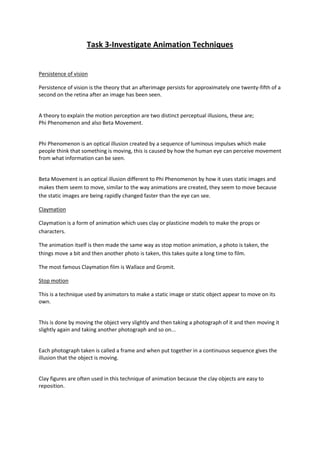
Task 3 investigate animation techniques
- 1. Task 3-Investigate Animation Techniques Persistence of vision Persistence of vision is the theory that an afterimage persists for approximately one twenty-fifth of a second on the retina after an image has been seen. A theory to explain the motion perception are two distinct perceptual illusions, these are; Phi Phenomenon and also Beta Movement. Phi Phenomenon is an optical illusion created by a sequence of luminous impulses which make people think that something is moving, this is caused by how the human eye can perceive movement from what information can be seen. Beta Movement is an optical illusion different to Phi Phenomenon by how it uses static images and makes them seem to move, similar to the way animations are created, they seem to move because the static images are being rapidly changed faster than the eye can see. Claymation Claymation is a form of animation which uses clay or plasticine models to make the props or characters. The animation itself is then made the same way as stop motion animation, a photo is taken, the things move a bit and then another photo is taken, this takes quite a long time to film. The most famous Claymation film is Wallace and Gromit. Stop motion This is a technique used by animators to make a static image or static object appear to move on its own. This is done by moving the object very slightly and then taking a photograph of it and then moving it slightly again and taking another photograph and so on... Each photograph taken is called a frame and when put together in a continuous sequence gives the illusion that the object is moving. Clay figures are often used in this technique of animation because the clay objects are easy to reposition.
- 2. Stop-frames were first seen in 1897 in The Humpty Dumpty Circus created by Albert E. Smith and J. Stuart Blackton. Stop-frames are still being used in recent years in movies such as The corpse bride and even in music videos such as Tool-Parabola. Computer generation Computer generation is where programmes such as flash are used to create animations, these are commonly used to make animations which are used on YouTube for short things, flash can also be used to make roll over buttons. Frame rate A frame rate is the frequency of a device that produces image frames. This term is used within films, computer graphics, videos and other forms of motion capture. Frame rate is often measured in FPS (Frames per Second) The higher the frame rate a film or video has means that the smoother the film or video looks and makes the static images look like they are moving smoother, the lower the frame rate a film or video uses means that the film or video doesn’t look as smooth and might look jumpy and the static images may not look very good. Movies played at the cinema are usually using around 25 frames per second. Frames Frames are the things that are used to put the actual drawing or things that you are going to use in the animation, each slide would contain a different thing such as a ball in one place, on the next slide it would move slightly and so on and when this is played it looks like the ball is bouncing. Key frames Kay frames are that main frames for things such as where the animation starts and ends and any important points during such as if the set changes or something different happens that isn’t small. Tweens can also be made between two key frames; this fills in the animation such as a ball on the left hand side on the first key frame and a ball on the right hand side on a second key frame, if a tween is made between these then the ball would move to its next position from the 1st frame to the second.
- 3. Onion skinning Onion skinning can be used in things such as flash to see the way that the animation moves, this helps to spot if anything is wrong and would need changing, this makes it a lot easier for the animated since they can easily spot if they have made a mistake anywhere, onion skinning also helps with moving things so that you know how far it has moved since the last frame etc. Tweening Tweens can also be made between two key frames; this fills in the animation such as a ball on the left hand side on the first key frame and a ball on the right hand side on a second key frame, if a tween is made between these then the ball would move to its next position from the first frame to the second.